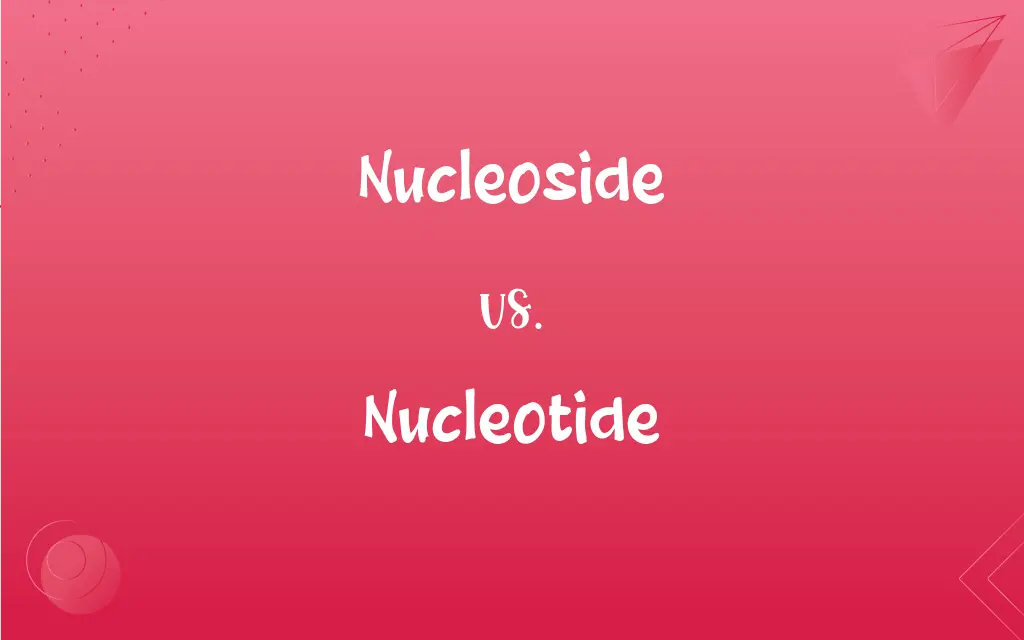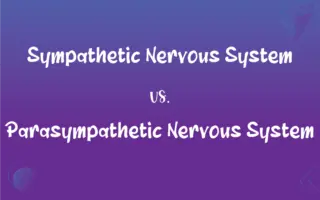Nucleoside vs. Nucleotide: What's the Difference?
Edited by Aimie Carlson || By Harlon Moss || Updated on October 3, 2023
A nucleoside consists of a base and a sugar, while a nucleotide consists of a base, sugar, and a phosphate group.

Key Differences
A nucleoside and a nucleotide are fundamental to understanding the genetic code embedded within DNA and RNA. The nucleoside, encompassing a nitrogenous base and a sugar molecule, primarily plays a role in various physiological processes and forms the backbone of genetic informational structures. On the other hand, nucleotides, composed of a nucleoside plus a phosphate group, are essential as energy carriers, signaling molecules, and are the building blocks of nucleic acids.
When considering the structures of nucleosides and nucleotides, it's essential to appreciate their roles in forming DNA and RNA. Nucleosides lack the phosphate group which nucleotides have, making the latter pivotal in energy transfer and storage within cells. Nucleotides, with their triphosphate form, like ATP, also act as energy currency within biological systems, something which nucleosides are not involved in.
Nucleosides are often involved in medicinal chemistry, with many antiviral and anticancer agents being nucleoside analogs. Unlike nucleotides, nucleosides, without the charged phosphate group, can traverse cellular membranes, influencing cellular activities by interfering with nucleic acid synthesis. Conversely, nucleotides serve as substrates for DNA and RNA polymerases during nucleic acid synthesis and perform roles in cellular signaling as second messengers.
Nucleosides can be phosphorylated by kinases within the cell to become nucleotides, illustrating a transformable relationship under physiological conditions. Nucleotides can also be dephosphorylated to become nucleosides. Thus, while these entities are distinct in structure and immediate function, their roles within cellular physiology and biochemistry are interlinked and convertible.
In a biological context, the distinction between nucleosides and nucleotides becomes crucial when studying genetic materials, energy transfer, and cellular signaling. Nucleosides serve as modulators and precursors, while nucleotides are immediate actors and carriers in bioenergy and genetic information transfer.
ADVERTISEMENT
Comparison Chart
Basic Composition
Sugar + Base
Sugar + Base + Phosphate group
Role in Genetics
Serves as a precursor
Fundamental unit of nucleic acids
Energy-related Role
Not directly involved
Directly involved (e.g., ATP, GTP)
Examples
Adenosine, Guanosine
Adenosine Triphosphate (ATP), Guanosine Triphosphate (GTP)
Presence in
Present in cellular functions
Vital in DNA, RNA, energy transfer, and cellular signaling
ADVERTISEMENT
Nucleoside and Nucleotide Definitions
Nucleoside
Nucleosides consist of a pentose sugar and a nitrogenous base.
Uridine is a nucleoside made up of uracil and ribose.
Nucleotide
Nucleotides can act as signaling molecules within the cell.
CAMP, a nucleotide, acts as a secondary messenger in various biological processes.
Nucleoside
Some antiviral drugs are analogs of nucleosides.
Acyclovir is a nucleoside analog used to treat herpes simplex virus infections.
Nucleotide
Nucleotides are molecules comprising a sugar, base, and phosphate group.
ATP, a high-energy molecule, is a nucleotide crucial for cellular activities.
Nucleoside
A nucleoside is a molecule formed of a nitrogenous base bound to a sugar.
Cytidine is a nucleoside that contains cytosine and ribose.
Nucleotide
Nucleotides serve as the building blocks of nucleic acids.
DNA is a long chain of nucleotides arranged in a specific sequence.
Nucleoside
Nucleosides can be converted into nucleotides by phosphorylation.
Adenosine becomes adenosine monophosphate (AMP) when phosphorylated.
Nucleotide
The phosphate group in nucleotides is essential for energy storage and transfer.
The release of energy occurs when ATP, a nucleotide, is hydrolyzed to ADP.
Nucleoside
Nucleosides act as precursors to nucleotides.
Guanosine, when phosphorylated, participates in forming nucleic acids.
Nucleotide
Nucleotides play a crucial role in storing and transferring energy.
GTP is a nucleotide involved in energy transfer within the cell.
FAQs
How is a Nucleotide different from a Nucleoside?
A nucleotide is a nucleoside with one or more phosphate groups attached to it.
Why is the phosphate group crucial in Nucleotides?
The phosphate group in nucleotides is vital for energy storage and transfer within cellular processes.
Can Nucleosides be converted into Nucleotides?
Yes, nucleosides can be converted into nucleotides through a process called phosphorylation.
What is a Nucleoside?
A nucleoside consists of a nitrogenous base covalently attached to a sugar.
What is the significance of Nucleosides in pharmacology?
Nucleoside analogs are utilized in medicinal chemistry, often used in antiviral and anticancer therapies.
How do Nucleotides contribute to genetic information?
Nucleotides, with their specific base sequences, encode genetic information in the structures of DNA and RNA.
Are Nucleosides and Nucleotides found in DNA?
Yes, nucleotides form the basic structural units of DNA, while nucleosides are nucleotides without the phosphate group.
Are ATP and GTP Nucleosides or Nucleotides?
ATP (Adenosine Triphosphate) and GTP (Guanosine Triphosphate) are nucleotides.
Is the sugar component the same in all Nucleosides?
No, the sugar in nucleosides can be either ribose (in RNA) or deoxyribose (in DNA).
Why is the order of Nucleotides important in DNA?
The specific sequence of nucleotides in DNA is crucial for encoding and transmitting genetic information accurately.
Can Nucleotides be derived from dietary sources?
Yes, nucleotides can be derived from dietary sources and are also synthesized within the body.
How does mutation affect Nucleotide sequences in DNA?
Mutations can alter the nucleotide sequence in DNA, potentially leading to changes in protein synthesis and function.
Can Nucleosides and Nucleotides be utilized in laboratory research?
Absolutely, nucleosides and nucleotides are fundamental in research, especially in studies involving genetics, microbiology, and cellular biology.
How are Nucleotides linked together to form DNA?
Nucleotides are linked together by phosphodiester bonds between the phosphate group and the sugar component to form polynucleotide chains in DNA.
Are Nucleosides essential for life?
Yes, nucleosides, as precursors to nucleotides, play crucial roles in various biological processes vital for life.
What is the role of Nucleosides in metabolic pathways?
Nucleosides can act as intermediates and be involved in various metabolic pathways within the cell.
Are there synthetic analogs of Nucleosides?
Yes, several synthetic nucleoside analogs are used in medical treatments, like antiviral drugs.
Can Nucleotides be synthesized in the body?
Yes, nucleotides can be synthesized in the body through de novo and salvage pathways.
How does the structure of a Nucleoside impact genetic information?
The nitrogenous base of a nucleoside pairs with its complementary base, facilitating the coding of genetic information.
What roles do Nucleotides play in cellular activities?
Nucleotides are involved in cellular processes like forming nucleic acids, energy transfer, and acting as signaling molecules.
About Author
Written by
Harlon MossHarlon is a seasoned quality moderator and accomplished content writer for Difference Wiki. An alumnus of the prestigious University of California, he earned his degree in Computer Science. Leveraging his academic background, Harlon brings a meticulous and informed perspective to his work, ensuring content accuracy and excellence.
Edited by
Aimie CarlsonAimie Carlson, holding a master's degree in English literature, is a fervent English language enthusiast. She lends her writing talents to Difference Wiki, a prominent website that specializes in comparisons, offering readers insightful analyses that both captivate and inform.































































